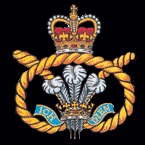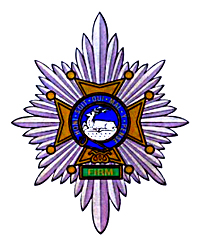
The Infantry of the British Army, part of the structure of the British Army, comprises 49 infantry battalions, from 19 regiments. Of these, 33 battalions are part of the Regular army and the remaining 16 a part of the Army Reserve. The British Army's Infantry forms a highly flexible organisation, taking on a variety of roles, including armoured, mechanised, air assault and light.

The Staffordshire Regiment was an infantry regiment of the British Army, part of the Prince of Wales' Division. The regiment was formed in 1959 by the amalgamation of the South Staffordshire Regiment and the North Staffordshire Regiment, and in 2007 was amalgamated with the Cheshire Regiment and the Worcestershire and Sherwood Foresters Regiment to become the 3rd Battalion, Mercian Regiment.

The Mercian Regiment is an infantry regiment of the British Army, which is recruited from five of the counties that formed the ancient kingdom of Mercia. Known as 'The Heart of England's Infantry', it was formed on 1 September 2007 by the amalgamation of three existing regiments. The Regiment has deployed on eight operational deployments since its formation.

The Worcestershire and Sherwood Foresters Regiment was an infantry regiment of the British Army, part of the Prince of Wales' Division. The regiment served as the county regiment for Derbyshire, Nottinghamshire and Worcestershire.

The Scottish Division was a British Army Infantry command, training and administrative apparatus designated for all Scottish line infantry units. It merged with the Prince of Wales' Division, to form the Scottish, Welsh and Irish Division in 2017.

The King's Division is a British Army command, training and administrative apparatus designated for infantry regiments in the North of England.
The West Midlands Regiment was a British Territorial Army regiment from 1999 to 2007.
The Royal Wessex Regiment was the name suggested for a regiment proposed by the initial discussions into the Future Army Structure brought up as part of Delivering Security in a Changing World. It was planned to be formed by the amalgamation of the Devonshire and Dorset Regiment and Royal Gloucestershire, Berkshire and Wiltshire Regiment.
A large regiment is a multi-battalion infantry formation of the British Army. First formed in the 1960s, large regiments are the result of the amalgamation of three or more existing single-battalion regiments, and perpetuate the traditions of each of the predecessor units.
The 98th Regiment of Foot was an infantry regiment of the British Army. It was originally raised in 1824 as the 98th Regiment of Foot, before assuming the title of the 98th Regiment of Foot in 1876. Later, in 1881, following the Childers Reforms of the British Army, the regiment was amalgamated with the 64th Regiment of Foot to become the Prince of Wales's Regiment. As the 64th Foot was senior to the 98th, the 98th became the 2nd Battalion in the new regiment. Throughout the course of the regiment's existence it served mostly overseas in South Africa, China and India.

The following is a list of the notable Regimental for military regiments of the British Army. In addition, all regiments have additional pieces for slow marches, marches for mounted parades, an pipe marches.
During the First World War the British Armed Forces was enlarged to many times its peacetime strength. This was done mainly by adding new battalions to existing regiments. Although sometimes identified by shoulder titles, generally the new battalions could not be identified from appearance. Consequently, the units in this list have been assembled considering only those as having a uniquely different cap badge.

This is an order of battle listing the Allied and Ottoman forces involved in the Gallipoli campaign during 1915.
The 1915 Birthday Honours were appointments by King George V to various orders and honours to reward and highlight good works by citizens of the British Empire. The appointments were made to celebrate the official birthday of The King, and were published in The London Gazette and in The Times on 3 June 1915.

The Scottish, Welsh and Irish Division is a British Army Infantry command, training and administrative formation for Scottish, Welsh and Irish line infantry regiments.













